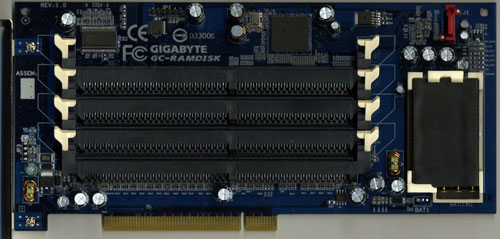
Original Link: https://www.anandtech.com/show/1742
Gigabyte's i-RAM: Affordable Solid State Storage
by Anand Lal Shimpi on July 25, 2005 3:50 PM EST- Posted in
- Storage
For years now, motherboard manufacturers have been struggling to find other markets to branch out to, in an attempt to diversify themselves, preparing for inevitable consolidation in the market. Every year at Computex, we'd hear more and more about how the motherboard business was getting tougher and we'd see more and more non-motherboard products from these manufacturers. For the most part, the non-motherboard products weren't anything special. Everyone went into making servers, then multimedia products, then cases, networking, security, water cooling; the list goes on and on.
This year's Computex wasn't very different, except for one thing. When Gigabyte showed us their collection of goodies for the new year, we were actually quite interested in one of them. And after we posted an article about it, we found that quite a few of you were very interested in it too. Gigabyte's i-RAM was an immediate success and it wasn't so much that the product was a success, but it was the idea that piqued everyone's interests.
Pretty much every time a faster CPU is released, we always hear from a group of users who are marveled by the rate at which CPUs get faster, but loathe the sluggish rate that storage evolves. We've been stuck with hard disks for decades now, and although the thought of eventually migrating to solid state storage has always been there, it's always been so very distant. These days, you can easily get a multi-gigabyte solid state drive if you're willing to spend the tens of thousands of dollars it costs to get one; prices actually vary from the low $1000s to the $100K range for solid state devices, obviously making them impractical for desktop users.
The performance benefits of solid state storage have always been tempting. With no moving parts, reliability is improved tremendously, and at the same time, random accesses are no longer limited by slow and difficult to position read/write heads. While sequential transfer rates have improved tremendously over the past 5 years, thanks to ever increasing platter densities among other improvements, it is the incredibly high latency that makes random accesses very expensive from a performance standpoint for conventional hard disks. A huge reduction in random access latency and increase in peak bandwidth are clear performance advantages to solid state storage, but until now, they both came at a very high price.
The other issue with solid state storage is that DRAM is volatile, meaning that as soon as power is removed from the drive, all of your data would be lost. More expensive solutions get around this by using a combination of a battery backup as well as a hard disk that keeps a backup of all data written to the solid state drive, just in case the battery or main power should fail.
Recognizing the allure of solid state storage, especially to performance-conscious enthusiast users, Gigabyte went about creating the first affordable solid state storage device, and they called it i-RAM.
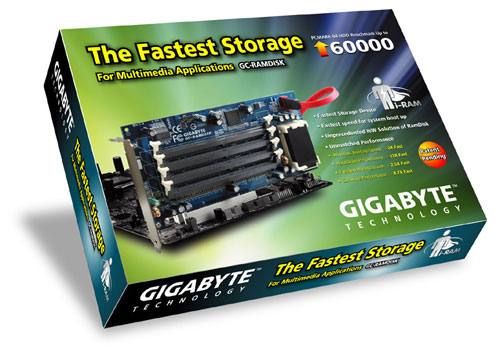
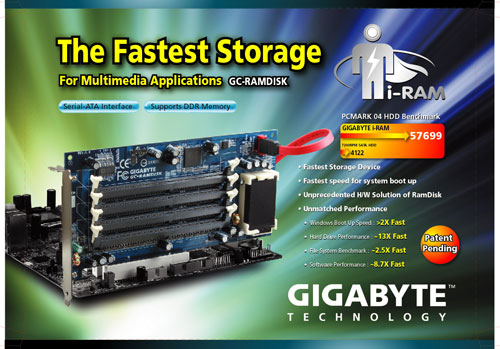
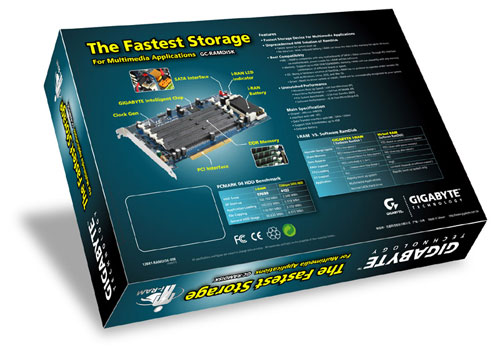
Through some custom logic, the i-RAM works and acts just like a regular SATA hard drive. But how much of a performance increase is there for desktop users? And is the i-RAM worth its still fairly high cost of entry? We've spent the past week trying to find out...
We All Scream for i-RAM
Gigabyte sent us the first production version of their i-RAM card, marked as revision 1.0 on the PCB.There were some obvious changes between the i-RAM that we received and what we saw at Computex.
First, the battery pack is now mounted in a rigid holder on the PCB. The contacts are on the battery itself, so there's no external wire to deliver power to the card.

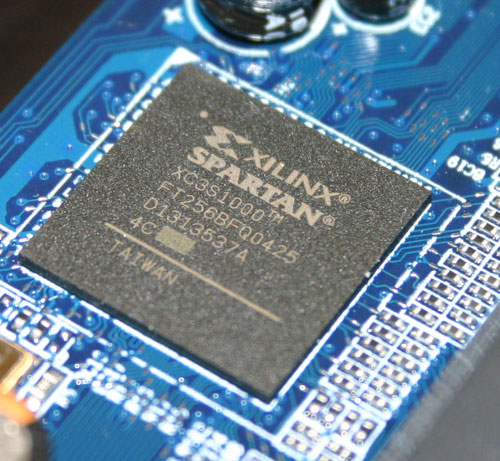
The Xilinx FPGA has three primary functions: it acts as a 64-bit DDR memory controller, a SATA controller and a bridge chip between the memory and SATA controllers. The chip takes requests over the SATA bus, translates them and then sends them off to its DDR controller to write/read the data to/from memory.
Gigabyte has told us that the initial production run of the i-RAM will only be a quantity of 1000 cards, available in the month of August, at a street price of around $150. We would expect that price to drop over time, and it's definitely a lot higher than what we were told at Computex ($50).
The i-RAM is outfitted with 4 184-pin DIMM slots that will accept any DDR DIMM. The memory controller in the Xilinx FPGA operates at 100MHz (DDR200) and can actually support up to 8GB of memory. However, Gigabyte says that the i-RAM card itself only supports 4GB of DDR SDRAM. We didn't have any 2GB unbuffered DIMMs to try in the card to test its true limit, but Gigabyte tells us that it is 4GB.
The Xilinx FPGA also won't support ECC memory, although we have mentioned to Gigabyte that a number of users have expressed interest in having ECC support in order to ensure greater data reliability.
Although the i-RAM plugs into a conventional 3.3V 32-bit PCI slot, it doesn't use the PCI connector for anything other than power. All data is transfered via the Xilinx chip and over the SATA connector directly to your motherboard's SATA controller, just like any regular SATA hard drive.
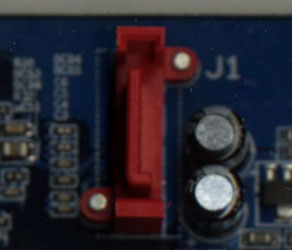
With SATA as the only data interface, Gigabyte made the i-RAM infinitely more useful than software based RAM drives because to the OS and the rest of your system, the i-RAM appears to be no different than a regular hard drive. You can install an OS, applications or games on it, you can boot from it and you can interact with it just like you would any other hard drive. The difference is that it is going to be a lot faster and also a lot smaller than a conventional hard drive.
The size limitations are pretty obvious, but the performance benefits really come from the nature of DRAM as a storage medium vs. magnetic hard disks. We have long known that modern day hard disks can attain fairly high sequential transfer rates of upwards of 60MB/s. However, as soon as the data stops being sequential and is more random in nature, performance can drop to as little as 1MB/s. The reason for the significant drop in performance is the simple fact that repositioning the read/write heads on a hard disk takes time as does searching for the correct location on a platter to position them. The mechanical elements of hard disks are what make them slow, and it is exactly those limitations that are removed with the i-RAM. Access time goes from milliseconds (1 x 10-3) down to nanoseconds (1 x 10-9), and transfer rate doesn't vary, so it should be more consistent.
Since it acts as a regular hard drive, theoretically, you can also arrange a couple of the i-RAM cards together in RAID if you have a SATA RAID controller. The biggest benefit to a pair of i-RAM cards in RAID 0 isn't necessarily performance, but now you can get 2x the capacity of a single card. We are working on getting another i-RAM card in house to perform some RAID 0 tests. However, Gigabyte has informed us that presently, there are stability issues with running two i-RAM cards in RAID 0, so we wouldn't recommend pursuing that avenue until we know for sure that all bugs are worked out.
i-RAM's Limitations
Since your data is stored on a volatile medium with the i-RAM, a loss of power could mean that everything stored on the card would be erased with no hopes for recovery. While a lot of users may keep their computers on 24/7, there are always occasional power outages that would spell certain doom for i-RAM owners. In order to combat this possibility, Gigabyte outfitted the i-RAM with its own rechargeable battery pack.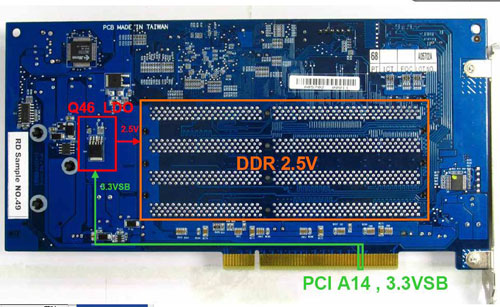
There are only three conditions where the i-RAM runs off of battery power:
1) When the i-RAM is unplugged from the PCI slot;For whatever reason, unplugging the i-RAM from the PCI slot causes its power consumption to go up considerably, and will actually drain its battery a lot quicker than the specified 16 hours. We originally did this to test how long the i-RAM would last on battery power, but then were later told by Gigabyte not to do this because it puts the i-RAM in a state of accelerated battery consumption.
2) When the power cable is unplugged from your power supply (or the power supply is disconnected from your motherboard; and
3) When the power button on your power supply is turned off.
For the most part, the i-RAM will always be powered. Your data is only at risk if you have a long-term power outage or you physically remove the i-RAM card.
If you run out of battery power, you will lose all data and the i-RAM will stop appearing as a drive letter in Windows as soon as you power it back up. You'll have to re-create the partition data and copy/install all of your files and programs over again.
The card features four LEDs that indicate its status: PHY_READY, HD_LED, Full and Charging.
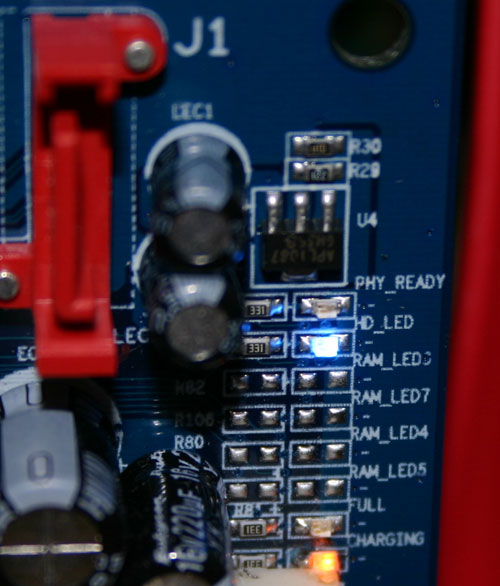
Using the i-RAM
To begin our testing, we loaded up the i-RAM with four 1GB DDR400 sticks. We didn't have any large DDR200 modules, so unfortunately we had to go with more modern DDR400. Using DDR500, DDR400 or DDR200 doesn't change performance at all, since the Xilinx controller runs them all at the same frequency.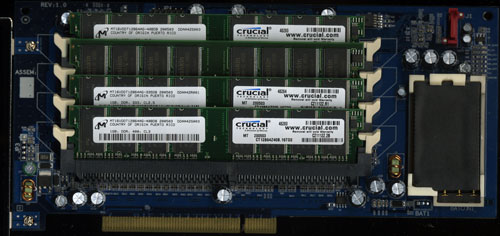
Powering the system on revealed the installation was a success; the BIOS reported the presence of the i-RAM as a regular storage device connected to our SATA controller:

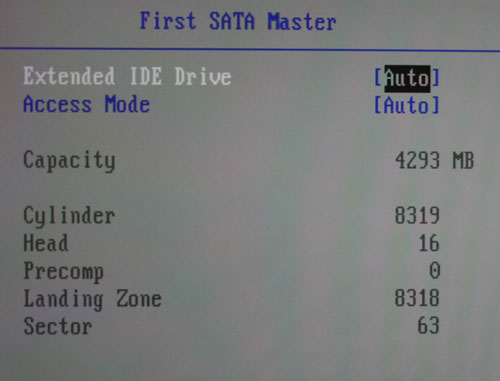
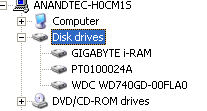
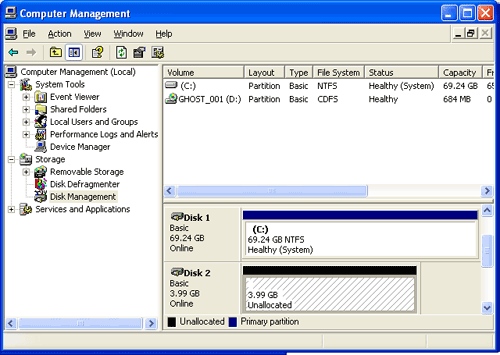
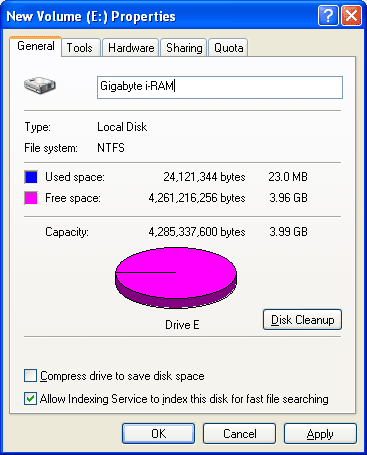
Also, all disk accesses are instantaneous; formatting the thing takes no time at all, and you can even "defragment" it (although, you get no benefit from doing so).
With the setup done, it was time to evaluate the i-RAM as more than just a novelty silent hard drive. Armed with our 4GB partition, we started testing...
The Test
We ran all of our tests on the following testbed unless otherwise noted:ASUS A8N SLI Deluxe nForce4 SLI Motherboard
AMD Athlon 64 FX-57 Processor
1 GB OCZ 2:2:2:7 DDR400 RAM
Seagate 7200.7 120 GB Hard Drive (boot drive)
Western Digital Raptor W740GD (test drive)
Gigabyte i-RAM w/ 4x1GB DDR400 modules (test drive)
We used the latest nForce 6.53 and ForceWare 77.72 drivers for our test bed, and paired it with the recently released GeForce 7800 GTX.
i-RAM Pure I/O Performance
We begin our usual hard disk drive test session with Intel's IPEAK benchmarking utility. We first run a trace capture on Winstone 2004's Business and Multimedia Content Creation benchmark runs to catch all of the IO operations that take place during each test. We then play each capture back using RankDisk, which reports back to us a mean service time, or average time that the drive takes to complete an IO operation.| Pure I/O Performance Comparison (Results in IO ops/second Higher is Better) | |||||
IPEAK Business Winstone 2004 |
IPEAK Multimedia Content Creation Winstone 2004 |
||||
| Gigabyte i-RAM (4GB) | 4347.8 |
1754.4 |
|||
| Western Digital Raptor (74GB) | 735.3 |
467.3 |
|||
Not too surprising is the i-RAM's dominance here, performing almost 6x the speed of the Raptor in the IPEAK trace of Business Winstone 2004 and 3.75x in the IPEAK MMCC trace.
Absolutely incredible I/O performance is to be expected from the i-RAM. The question is, how does it translate into real world performance?
i-RAM as a Paging Drive
One question that we've seen a lot is whether or not the i-RAM can be used to store your pagefile. Since the i-RAM behaves just like a regular hard drive, Windows has no problem using it to store your pagefile, so the "can you" part of that question is easily answered. The real question happens to be, "should you?"We have heard arguments on both sides of the fence; some say that Windows inefficiently handles memory and inevitably pages to disk even when you have memory to spare, while others say that you'd be stupid to put your pagefile on an i-RAM rather than just add more memory to your system. So, which is it?
Unfortunately, this is the type of thing that's difficult to benchmark, but it is the type of thing that's pretty easy to explain if you just sit down and use the product. We set up a machine, very similar to how we would a personal system, but tended to focus on memory hogs - web pages with lots of Flash, Photoshop, etc. Of course, we opened them all up at once, switched between the applications, used them independently, simultaneously, basically whatever we could do to stress the system as it normally would be stressed.
At the same time, we monitored a number of things going on - mainly the size of the pagefile, the amount of system memory used, the frequency of disk accesses, pagefile usage per process... basically everything we could get our hands on through perfmon to give us an idea if Windows was swapping to disk or not.
The end result? There was no real tangible performance difference between putting more memory in the system and using the hard disk for the pagefile or putting less memory in the system and using the i-RAM for the pagefile. Granted, if we had a way of measuring the overall performance, it would have shown that we would be much better off with more memory in the system (it runs faster, and it is accessed much quicker than off the i-RAM).
The only benefit that we found to using the i-RAM to store our pagefile was if you happened to have a couple GBs of older DDR200 memory lying around; that memory would be useless as your main system memory in a modern machine, but it'd make a lot better of a pagefile than a mechanical hard disk.
One more situation we encountered that would benefit from storing your pagefile on the i-RAM was those seemingly random times when Windows swaps to disk for no reason. But for the most part, our system was slower when we had less memory and stored the swapfile in it than when we had more memory and less swap file.
Adobe Photoshop is a slightly different creature as it keeps a scratch disk that is separate from the Windows pagefile. We tested Photoshop and used the i-RAM as our scratch disk, but in all cases it always made more sense to just throw more memory at Photoshop to improve performance where we ran out of memory. If the operations you're performing in Photoshop can fit into system memory, then you'll never touch the scratch disk.
Overall, based on our testing, the i-RAM doesn't make much sense as a paging drive unless you have the spare memory. The problem with "spare" DDR200 memory is that it is most likely in small 64MB, 128MB or maybe 256MB sizes, which doesn't buy you much space on an i-RAM drive. For most people, you're much better off just tossing more memory in your system.
i-RAM as a boot drive
Since the i-RAM appears as a normal hard drive, you can install Windows on it just like you would a regular hard drive with no extra drivers (assuming that none are needed for your SATA controller).A full install of Windows XP Pro can easily fit on a 4GB i-RAM and even on a 2GB i-RAM, but you have to be careful not to install applications into the C:\Program Files directory and disable System Restore for the i-RAM drive among other precautions. Why would you ever want to install your OS on an i-RAM card? We came up with two possibilities:
First off, loading your OS on the i-RAM will reduce boot times.
| Boot Time Comparison | |||||
Windows Boot Time (Lower is Better) |
|||||
| Gigabyte i-RAM (4GB) | 9.12s |
||||
| Western Digital Raptor (74GB) | 14.06s |
||||
With a Western Digital Raptor, you can go from the boot menu to the Windows desktop in 14.06 seconds; with the i-RAM, it takes 9.12 seconds. It's not instantaneous, but it's definitely quicker and noticeable.
Our thoughts are that with further optimization, the boot process can be better tuned for very low latency storage devices such as the i-RAM, but that won't happen with any currently shipping version of Windows.
The second reason for installing your OS on an i-RAM card is a bit more specific, but one we came up with when thinking about a secondary benefit of Gigabyte's i-RAM: it's silent.
You could theoretically build a home theater computer using just the i-RAM to hold your OS and map a network drive (hopefully kept in another room) to hold all of your media (e.g. music, movies, pictures, etc.). Paired with a silent PSU and a very quiet running CPU fan (maybe even on a Pentium M based system), you can have a truly silent HTPC, thanks to the i-RAM. You'd ideally want whatever database of your media collection to be stored on the network drive and not your OS, just in case something ever happened causing your i-RAM to lose its data, but it is a viable use for Gigabyte's i-RAM.
i-RAM for Gamers
Although you definitely need more memory if your game is pausing during gameplay to swap to disk, level load times can be very annoying, especially with the excruciatingly long load times of some recent popular titles such as Unreal Tournament 2004 and Battlefield 2. So, what about using the i-RAM as a "game drive" to store whatever game you happen to be playing the most at the time, and hopefully reduce those pesky load times?So, we went to test a handful of games, Splinter Cell 3, Doom 3, Battlefield 2 and UT2004, and in that quest, we ran into our first problem - UT2004 required around 5GB of space to install, and we only had 4GB on our i-RAM. The rest of our tests proceeded without a problem, but the capacity issue is one that was an underlying theme of our testing with the i-RAM: its Achilles' heel is its capacity limitation more than anything else.
Most of the games that we installed on the i-RAM occupied between 1GB and 3.5GB of space, but we wouldn't put it past many developers to begin pushing those limits very soon, if they aren't already. But then again, you could always add another i-RAM later, so how'd it fare in the games we could install on it?
| Game Level Load Time Comparison (Lower is Better) | |||||
Splinter Cell: CT |
Doom 3 |
Battlefield 2 |
|||
| Gigabyte i-RAM (4GB) | 8.0s |
19.6s |
20.83s |
||
| Western Digital Raptor (74GB) | 10.59s |
25.78s |
25.67s |
||
First off, we had Splinter Cell 3 - we ran the lighthouse benchmark that ships with the game and timed the loading screen for the level. The Raptor came in at just under 11 seconds, while the i-RAM came in at 8 seconds. Not a huge improvement, and honestly not overly noticeable (other than the fact that there was no disk crunching), but it was a measurable difference.
Doom 3 proved to be a bit more appreciative of the i-RAM's efforts; the Raptor came in at just under 26 seconds, while the i-RAM loaded the first level in 19.6 seconds. Again, if you were expecting the load time to drop to instantaneous, that's not going to happen, but the reduction in this case was quite measurable.
Our final test was the big one - Battlefield 2. For this test, we used our benchmark level and once again, timed the ever-so-long loading screen. The Raptor got us out of that screen in 25.67 seconds, and the i-RAM did it in 20.83 - a similar performance gain to what we saw in Doom 3.
Overall, we saw some reasonably tangible performance improvements in game level load times - but nothing we would characterize as spectacular. For the money, you're much better off buying a better video card to improve your gaming performance; but if you happen to already own a pair of GeForce 7800 GTXes, then maybe an i-RAM is in your future.
i-RAM for Applications
Gamers aren't the only ones plagued by long load times. There are a handful of applications that do take a reasonable amount of time to load that could be benefitted by being installed on an i-RAM card.We tried a wide variety of applications, everything from Office to Photoshop and 3ds max. What we found was the following: for the most part, the majority of applications are as fast as they are going to get on any current-generation SATA drive. We noticed no performance difference loading any of the MS Office applications on a Raptor or on the i-RAM card.
| Application Load Time Comparison (Lower is Better) | |||||
Adobe Photoshop CS |
Microsoft Outlook 2003 |
Microsoft Excel 2003 |
|||
| Gigabyte i-RAM (4GB) | 3.537s |
2.51s |
1.654s |
||
| Western Digital Raptor (74GB) | 6.037s |
2.562s |
1.765s |
||
The biggest differences that we saw were obviously with applications that took a long time to load to begin with, one of the most popular culprits being Adobe Photoshop CS (we didn't have CS2 available at the time of testing).
On a WD Raptor, Photoshop CS took about 6 seconds to load; it's not much when you time it, but it can feel like an eternity when you're actually sitting there waiting for it. The i-RAM cut the load time down to 3.537 seconds, a significant reduction, and very noticeable.
The major issue with the i-RAM and using it to install our applications on it, once again, becomes size. But it is entirely possible to keep a handful of your very frequently used applications on the card, giving you faster access to them.
File Copy and Archive Performance
The one area where the i-RAM truly offered impressive performance was when copying files on the i-RAM itself, mainly because a file copy is mostly an I/O bound process.| 300MB File Copy | |||||
Time in Seconds (Lower is Better) |
|||||
| Gigabyte i-RAM (4GB) | 25.25s |
||||
| Western Digital Raptor (74GB) | 77.689s |
||||
Copying a 300MB folder containing the Firefox source code from the Raptor to itself took about 77 seconds, yielding just under 4MB/s. Doing the same on the i-RAM took about 25 seconds, resulting in an average transfer rate of about 12MB/s. Note that both the Raptor and the i-RAM were far from their peak theoretical transfer rates, indicating that even the i-RAM is susceptible to some sort of performance overhead.
Next up? Copying a 693MB iso from the drive to itself:
| 693MB File Copy | |||||
Time in Seconds (Lower is Better) |
|||||
| Gigabyte i-RAM (4GB) | 6.922s |
||||
| Western Digital Raptor (74GB) | 26.304s |
||||
The i-RAM averaged around 100MB/s and copied the file in 6.922 seconds. The Raptor did so in 26.305 seconds at an average of 26.3MB/s.
Finally, we copied our 1.7GB Battlefield 2 install directory:
| 1.76GB File Copy | |||||
Time in Seconds (Lower is Better) |
|||||
| Gigabyte i-RAM (4GB) | 31.719s |
||||
| Western Digital Raptor (74GB) | 95.953s |
||||
Archive operations are also a lot quicker on the i-RAM. Here's how long it took to create a RAR archive of our Firefox source folder:
| WinRAR Archive Creation | |||||
Time in Seconds (Lower is Better) |
|||||
| Gigabyte i-RAM (4GB) | 57s |
||||
| Western Digital Raptor (74GB) | 70s |
||||
Un-archiving a 382MB RAR set provided a much closer competition between the Raptor and the i-RAM:
| WinRAR Archive Extraction | |||||
Time in Seconds (Lower is Better) |
|||||
| Gigabyte i-RAM (4GB) | 15s |
||||
| Western Digital Raptor (74GB) | 19s |
||||
Overall Performance
How does the i-RAM impact overall system performance? In order to find out, we installed Winstone on the drive and compared its benchmark results to the Raptor:| Overall Performance Comparison (Higher is Better) | |||||
Business Winstone 2004 |
Multimedia Content Creation Winstone 2004 |
||||
| Gigabyte i-RAM (4GB) | 24.5 |
36.3 |
|||
| Western Digital Raptor (74GB) | 23.9 |
35.4 |
|||
What's very interesting here is that there's very little performance gain from running Winstone on the i-RAM, which tells us that Winstone isn't nearly as disk bound as we originally thought.
We wanted to run other benchmark suites on the i-RAM; however, we ran into capacity issues once again.
One of the biggest advantages of the i-RAM is its random access performance, which comes into play particularly in multitasking scenarios where there are a lot of disk accesses. In order to see if this translates into any tangible real world performance gains, we turned to the Multitasking Business Winstone tests:
"This test uses the same applications as the Business Winstone test, but runs some of them in the background. The test has three segments: in the first, files copy in the background while the script runs Microsoft Outlook and Internet Explorer in the foreground. The script waits for both foreground and background tasks to complete before starting the second segment. In that segment, Excel and Word operations run in the foreground while WinZip archives in the background. The script waits for both foreground and background tasks to complete before starting the third segment. In that segment, Norton AntiVirus runs a virus check in the background while Microsoft Excel, Microsoft Project, Microsoft Access, Microsoft PowerPoint, Microsoft FrontPage, and WinZip operations run in the foreground."
| Winstone Multitasking Performance Comparison (Higher is Better) | |||||
Test 1 |
Test 2 |
Test 3 |
|||
| Gigabyte i-RAM (4GB) | 5.55 |
2.98 |
3.1 |
||
| Western Digital Raptor (74GB) | 2.78 |
2.93 |
3.04 |
||
The biggest performance gain is in the first multitasking test, which is the file copy test while Outlook and IE run. The performance advantage here is tremendous, with the i-RAM generating a score almost twice that of the Raptor.
The rest of the tests show very little performance improvement. We'd guess that the majority of the boost in the first test is due to the file copy that takes place during the run.
Final Words
Armed with four 1GB sticks, we ran into more than a few cases where the i-RAM's size limitations made it impractical for use in our system. Although 4GB is enough for a good deal of applications, an 8GB card would get far more use. Based on the size of applications and games that we tried installing on the card, we'd say that 8GB would be the sweet spot - which unfortunately would either take two cards or much more expensive DIMMs. We wouldn't recommend going with a 2GB partition unless you have a very specific usage model that you know won't use any more. With only 2GB, we quickly found ourselves very constrained for space. The past few years of having much more storage than we could ever ask for has unfortunately made us forget about how tough things can get with only a couple of GBs of space.Although the card is presently cramped with just four DIMM slots, one option for Gigabyte is to introduce a two-slot version with support for eight DIMMs. The problem that we foresee most people running into is that older memory may be plentiful, but is usually smaller in size. By the time current Athlon 64 users migrate to DDR2, they may have a handful of 512MB or 1GB sticks laying around, but presently, the only spare memory that you're most likely to have is a few 128MB or 256MB DDR modules from older builds. Without being able to re-use older memory, the cost of outfitting an i-RAM card with a full 4GB of memory starts getting expensive. At $90 per gigabyte of memory, you're talking about $360 just in memory costs, plus another $150 for the card itself. For most folks, that's a pretty steep entry fee, but then again, if you've just splurged on a GeForce 7800 GTX, then maybe your budget can handle it.
But that right there hits the nail on the head; by no means is the i-RAM a cheap upgrade, but then again, neither is an Athlon 64 X2, or a brand new 7800 GTX, or an SLI motherboard. If you put it in perspective, an i-RAM with 4GB of brand new DDR400 memory isn't all that expensive compared to some of the other upgrades that we've recommended recently. So the question then becomes, is Gigabyte's i-RAM as important to your overall system performance as an Athlon 64 X2 or a GeForce 7800 GTX?
For gamers, there is a slight improvement in level load times if you keep your game on the i-RAM. Most games will fit on a 4GB card, but as we noticed during our testing, not all will. The reduction in load times isn't nearly as dramatic as we had originally thought. It seems as if level load times are actually more affected by CPU and platform performance than just disk performance.
Those users who have one or two applications that occupy all of their time, and tend to take a while to load or work with due to constant disk access would be more than happy with the i-RAM. By far, the biggest performance improvements we saw when using the i-RAM were obviously with disk intensive operations such as file copying. If your applications or usage models involve a lot of data movement without much manipulation, then the i-RAM may very well be what you need.
At the same time, for all of the situations where the i-RAM was quite useful, there were a number where it wasn't. Multitasking performance went up, but only in one out of the three Winstone tests, and even then, it's going to be rather tough to install a large number of applications on the i-RAM due to its size limitations, so your multitasking performance benefits will be numbered. Game load times weren't always improved by a great deal and as we saw with the Business and Multimedia Content Creation Winstone tests, sometimes you are better off with a faster CPU than with the i-RAM.
The important thing to focus on is that thanks to Gigabyte's battery system, data-loss was never an issue during our use of the card; and despite the lack of ECC memory support, we never had any data corruption during our testing.
In the end, the i-RAM is an interesting addition to a system, but it's usefulness will truly vary from one user to the next. With a bit more capacity, and especially for those users who happen to have a few 1GB sticks laying around, the i-RAM could be a very powerful addition to your system. Hats off to Gigabyte for making something useful, and we can't wait to see rev 2...

